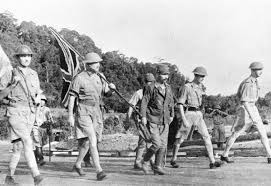Vaša košarica je trenutno prazna!
The image of soldiers on bicycles conquering a strategic stronghold sounds like something out of a quirky historical anecdote. But did the British conquer Singapore with bicycles? The answer is a resounding no. This popular misconception flips the historical narrative on its head. In reality, it was the Japanese who famously, and effectively, utilized bicycles in their lightning campaign to capture Singapore from the British during World War II.
Often dubbed “Fortress Singapore,” the British stronghold was touted as an impenetrable bastion, primarily defended against an attack from the sea. British military planners had poured resources into coastal defenses, building massive naval guns designed to repel an invasion force approaching from the south. However, this strategic focus proved to be Singapore’s fatal flaw.
The Japanese, under the brilliant leadership of General Tomoyuki Yamashita, launched their audacious offensive down the Malayan Peninsula in December 1941. Their strategy was swift, relentless, and completely unexpected by the Allied forces. Rather than a direct naval assault, the Japanese chose a land invasion, pushing south through dense jungle terrain and poorly defended roads.
This is where the bicycles entered the historical record. The Japanese Imperial Army extensively used “bicycle infantry”. These were not just a few soldiers on bikes; entire units were equipped with them. The bicycles offered several critical advantages:
- Speed and Mobility: Soldiers could cover vast distances far more quickly than on foot, allowing for rapid advances that constantly outmaneuvered and surprised the retreating British and Commonwealth forces.
- Logistics: Bicycles required no fuel, were easy to maintain, and could carry significant amounts of equipment, ammunition, and even wounded soldiers.
- Terrain Adaptability: They navigated the often-poorly maintained roads and jungle tracks with ease, bypassing demolished bridges and choked supply lines.
- Silence: Their quiet movement allowed for stealthy approaches and surprise attacks.
The “bicycle blitz” was a psychological weapon as much as a tactical one. The speed of the Japanese advance shattered Allied morale. Commanders had envisioned a prolonged defense, but the Japanese forces seemed to materialize out of nowhere, constantly pressing their advantage.
The British defense, despite their numerical superiority in some areas, was ultimately outmaneuvered and underprepared for this form of warfare. Their static, sea-focused defenses were largely irrelevant to an attack coming from the north. Exhausted and cut off, the Allied forces under Lieutenant-General Arthur Percival surrendered Singapore to the Japanese on February 15, 1942, marking one of the largest capitulations in British military history.
So, while the image of British soldiers on bicycles might make for a curious tale, the truth is a stark reminder of Japanese ingenuity and strategic adaptability in overcoming a supposedly impregnable fortress, with the humble bicycle playing a surprisingly significant role in their remarkable victory.

